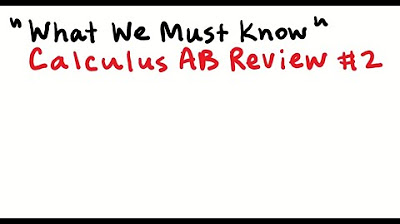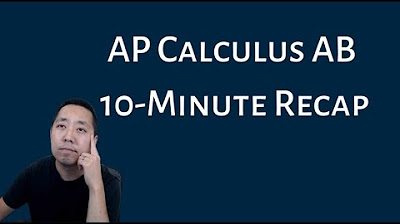🚨EXPERT 🚨Tips for How to Get a 💥5 on the 2022 AP Calculus AB Exam💥 [What You REALLY Need to Know]
TLDRIn this video script, Mr. Antonucci, an experienced AP Calculus teacher, shares expert tips for achieving a top score on the AP Calculus AB exam. He emphasizes the importance of understanding specific concepts over general exam strategies. Key advice includes using a graphing calculator effectively for derivatives, integrals, and solving equations, ensuring accuracy to three decimal places in answers, and knowing how to apply theorems like the Extreme Value Theorem, Intermediate Value Theorem, and Mean Value Theorem. He also discusses the need to justify conclusions about relative maxima, minima, and points of inflection using derivative tests, and the importance of understanding the difference between speed, velocity, and displacement. Additionally, he highlights the significance of including units in answers and being precise with function-related questions. The summary underscores the value of Mr. Antonucci's insights for students aiming to excel in AP Calculus.
Takeaways
- 📚 **Expertise and Experience**: Mr. Antonucci's advice is based on over 15 years of teaching AP Calculus, attending AP seminars, and grading hundreds of student responses.
- 📈 **Graphing Calculator Usage**: Students are allowed to use graphing calculators for calculating derivatives, definite integrals, graphing functions, and solving equations, but must use correct notation for free-response questions.
- 📝 **Accuracy in Answers**: Responses, especially for definite integrals, must be accurate to three decimal places unless providing an exact answer.
- 🔢 **Rounding and Calculation**: For intermediate steps, maintain as many decimal places as possible to ensure the final answer is accurate to three decimal places.
- 📉 **Theorems Understanding**: Familiarize yourself with key theorems (Extreme Value, Intermediate Value, Mean Value) and understand their conditions and applications.
- 📌 **Derivative Tests**: Know how to apply the first and second derivative tests to identify relative maxima, minima, and points of inflection.
- 🔴 **Trigonometric Values**: Memorize the values of sine and cosine for special angles and understand how to derive other trigonometric functions from them.
- 📏 **Function Interpretation**: Be clear about whether the question is about the original function, its derivatives, or integrals, and respond accordingly.
- 🏃 **Units and Physical Quantities**: Always include units in your answers when the problem specifies them, as they can contribute to the score.
- 🚫 **Misunderstandings to Avoid**: Do not rely on graph interpretation alone for justifying extrema or inflection points; use the appropriate mathematical tests.
- ⭕️ **Solids of Revolution**: When calculating volumes of solids created by rotation, ensure the representative slice is always perpendicular to the axis of rotation.
Q & A
What are the main areas where a graphing calculator can be used in the AP Calculus exam?
-A graphing calculator can be used for calculating derivatives, the value of a derivative, the value of a definite integral, graphing a function in an arbitrary viewing window, and solving equations graphically by finding the intersection points.
What is the importance of using correct notation when solving problems on a calculator-allowed section of the AP Calculus exam?
-Using correct notation is crucial because it demonstrates the understanding of mathematical concepts and processes. It also ensures that the work is accurately represented, which is important for grading purposes.
How should students approach solving for intersection points of two functions on the AP Calculus exam?
-Students should write down the equation they are solving to find the intersection points and then list the intersection points (x value, y value, or both). They do not need to show all the algebra if it's a calculator-allowed portion.
What precision is required for answers on the AP Calculus exam?
-Answers must be accurate to at least three decimal places unless providing an exact answer. For exact values like pi, students should write the exact value or an approximation that is accurate to three decimal places.
How should students handle rounding during intermediate steps of a calculation on the AP Calculus exam?
-Students should aim to keep as many decimal places as possible during intermediate steps to maintain accuracy. Alternatively, they can use the storing feature on their graphing calculator to store numbers and use those in calculations.
Why is it important to understand the conditions and results of theorems like the Extreme Value Theorem, Intermediate Value Theorem, and Mean Value Theorem in AP Calculus?
-Understanding these theorems is important because they often form the basis of questions that require conclusions or justifications. Students need to know when to apply these theorems and how to explain their application in the context of a given problem.
What is the difference between justifying a relative extremum and an absolute extremum on the AP Calculus exam?
-Relative extrema are justified using the first or second derivative test, while absolute extrema are determined using the candidates test, which involves comparing the values at the endpoints of the interval and the critical numbers.
Why is it a common mistake to assume a point of inflection occurs only when the second derivative is zero?
-A point of inflection occurs not only when the second derivative is zero or undefined but also when the second derivative changes sign as the function passes over that point. A zero second derivative alone is not sufficient.
What are the special angles for which students should memorize the values of the trigonometric functions for the AP Calculus exam?
-Students should memorize the values of sine and cosine for the angles 0, pi/6, pi/4, pi/3, and pi/2 in the first quadrant. They can then use the symmetry of the unit circle to determine the values for other quadrants.
Why is it crucial to pay attention to the function or its derivatives when a problem is asking about different levels of a function?
-Students need to carefully read and understand whether the question is about the original function, its first derivative, second derivative, or a definite integral. Misinterpretation can lead to answering a different question than what was asked.
What is the significance of including units in every answer on the AP Calculus free response questions?
-Including units is important because it shows the understanding of the physical context of the problem. Forgetting to include units can lead to losing points, as it may be a specific point allocated for the unit in the grading scheme.
How does the method of slicing for volume calculation in solids of revolution relate to the axis of rotation?
-The representative slice for volume calculation is always perpendicular to the axis of rotation. If the axis is vertical, a horizontal slice is made, and if the axis is horizontal, a vertical slice is made. The thickness of the slice determines the variable of integration.
Outlines
📚 AP Calculus Exam Preparation Tips
In this paragraph, Mr. Antonucci shares his expertise in AP Calculus, highlighting his extensive experience in teaching and grading the exam. He emphasizes the importance of understanding specific AP Calculus strategies rather than generic test-taking advice. He covers the use of graphing calculators for certain tasks, the necessity of using correct mathematical notation, and the importance of accuracy to three decimal places in answers. He also touches on the process of solving for intersection points of functions and the implications for various calculus problems.
🔍 Deep Dive into Theorems and Problem-Solving in AP Calculus
The focus of this paragraph is on the application of key theorems in AP Calculus, such as the Extreme Value Theorem, Intermediate Value Theorem, and Mean Value Theorem. Mr. Antonucci advises students to be well-versed in the conditions and results of these theorems to effectively use them in justifying answers. He also discusses the common pitfalls students encounter when identifying relative maxima, minima, and points of inflection, stressing the need to apply the first or second derivative test and understand the concept of concavity.
📏 Understanding Trigonometric Functions and AP Calculus Concepts
This paragraph emphasizes the need to know the values of the six trigonometric functions at special angles and how to derive other trigonometric functions from sine and cosine. Mr. Antonucci also clarifies the difference between speed and velocity, total distance traveled, displacement, and final position. He advises on the careful consideration of functions and their derivatives when solving problems and the importance of correctly identifying which function is being referred to in multi-function problems.
📐 Solids of Revolution and Unit Awareness in AP Calculus
The final paragraph discusses the importance of including units in answers for problems that require them, as omitting them can significantly impact the score. Mr. Antonucci also explains the concept of solids of revolution, particularly the orientation of the representative slice in relation to the axis of rotation and how it dictates the variable of integration. He concludes with encouragement and a reminder to subscribe for more helpful content and to check out his comprehensive video on AP Calculus exam preparation.
Mindmap
Keywords
💡AP Calculus
💡Free Response Questions
💡Derivatives
💡Definite Integrals
💡Theorems
💡First and Second Derivative Tests
💡Trigonometric Functions
💡Units
💡Velocity and Speed
💡Solids of Revolution
💡Displacement vs. Distance
Highlights
Mr. Antonucci shares expert tips for achieving a top score on the AP Calculus AB exam, drawing from over 15 years of teaching experience.
Emphasizes the importance of understanding specific AP Calculus concepts rather than general exam tips.
Advises on the proper use of graphing calculators for calculating derivatives, integrals, graphing functions, and solving equations.
Stresses the need for accurate notation when solving problems, even when a calculator is used for calculations.
Discusses how to approach solving for intersection points of functions and the importance of writing down the equations and points.
Mentions the requirement for answers to be accurate to at least three decimal places, with examples and rounding advice.
Suggests using the calculator's storing feature to simplify calculations involving many decimal places.
Explains the importance of understanding and applying key theorems such as the Extreme Value Theorem, Intermediate Value Theorem, and Mean Value Theorem.
Advises on how to properly justify the existence of relative maxima, minima, and points of inflection using derivative tests.
Clarifies the difference between relative and absolute extrema and how to address each in exam problems.
Highlights the necessity of memorizing special angle values for trigonometric functions for non-calculator portions of the exam.
Warns against misunderstanding the question's focus, such as differentiating between a function and its derivatives or integrals.
Cautions about carefully reading problems that involve multiple functions and ensuring answers correspond to the correct function.
Stresses the importance of including units in answers where applicable, as it can significantly impact scoring.
Differentiates between concepts of speed, velocity, total distance traveled, displacement, and final position for motion problems.
Provides guidance on volume problems involving solids of revolution, emphasizing the orientation of slices relative to the axis of rotation.
Encourages students to watch additional videos for a comprehensive understanding of AP Calculus exam requirements and to subscribe for updates.
Transcripts
5.0 / 5 (0 votes)
Thanks for rating:





